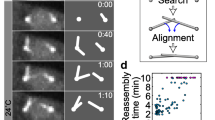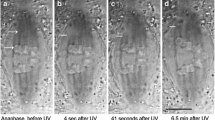Abstract
The mitotic spindle is an important intermediate structure in eukaryotic cell division, in which each of a pair of duplicated chromosomes is attached through microtubules to centrosomal bodies located close to the two poles of the dividing cell. Several mechanisms are at work toward the formation of the spindle, one of which is the ‘capture’ of chromosome pairs, held together by kinetochores, by randomly searching microtubules. Although the entire cell cycle can be up to 24 hours long, the mitotic phase typically takes only less than an hour. How does the cell keep the duration of mitosis within this limit? Previous theoretical studies have suggested that the chromosome search and capture is optimized by tuning the microtubule dynamic parameters to minimize the search time. In this paper, we examine this conjecture. We compute the mean search time for a single target by microtubules from a single nucleating site, using a systematic and rigorous theoretical approach, for arbitrary kinetic parameters. The result is extended to multiple targets and nucleating sites by physical arguments. Estimates of mitotic time scales are then obtained for different cells using experimental data. In yeast and mammalian cells, the observed changes in microtubule kinetics between interphase and mitosis are beneficial in reducing the search time. In Xenopus extracts, by contrast, the opposite effect is observed, in agreement with the current understanding that large cells use additional mechanisms to regulate the duration of the mitotic phase.
Similar content being viewed by others
References
Belmont, L. D., Hyman, A. A., Sawin, K. E., & Mitchison, T. J. (1990). Real-time visualization of cell cycle dependent changes in microtubule dynamics in cytoplasmic extracts. Cell, 62, 579.
Bicout, D. J. (1997). Green’s functions and first passage time distributions for dynamic instability of microtubules. Phys. Rev. E, Stat. Nonlinear Soft Matter Phys., 56, 6656.
Desai, A., & Mitchison, T. J. (1997). Microtubule polymerization dynamics. Annu. Rev. Cell Dev. Biol., 13, 83.
Dogterom, M., & Leibler, S. (1993). Physical aspects of growth and regulation of microtubule structures. Phys. Rev. Lett., 70(9), 1347.
Flyvbjerg, H., Holy, T. E., & Leibler, S. (1996). Microtubule dynamics: caps, catastrophes, and coupled hydrolysis. Phys. Rev. E, Stat. Nonlinear Soft Matter Phys., 54, 5538.
Gopalakrishnan, M., Borowski, P., Jülicher, F., & Zapotocky, M. (2007). Response and fluctuations of a two-state signaling module with feedback. Phys. Rev. E, Stat. Nonlinear Soft Matter Phys., 76, 021904.
Govindan, B. S., & Spillman, W. B., Jr. (2004). Novel steady state of a microtubule assembly in a confined geometry. Phys. Rev. E, Stat. Nonlinear Soft Matter Phys., 70, 032901.
Gregoretti, I.V., Margolin, G., Alber, M. S., & Goodson, H. V. (2006). Insights into cytoskeletal behavior from computational modeling of dynamic microtubules in a cell-like environment. J. Cell Sci., 119, 4781.
Hayde, J. H., Bowser, S. S., & Reider, C. L. (1990). Kinetochores capture astral microtubules during chromosome attachment to the mitotic spindle: direct visualization in live newt lung cells. J. Cell Biol., 111, 1039.
Holy, T. E., & Leibler, S. (1994). Dynamic instability of microtubules as an efficient way to search in space. Proc. Natl. Acad. Sci. USA, 91, 5682.
Howard, J., & Hyman, A. A. (2007). Microtubule polymerases and depolymerases. Curr. Opin. Cell Biol., 19, 31.
Kirschner, M., & Mitchison, T. J. (1986). Beyond self-assembly: from microtubules to morphogenesis. Cell, 45, 329.
Komarova, Y. A., Vorobjev, I.A., & Borisy, G. G. (2002). Life cycle of MTs: persistent growth in the cell interior, asymmetric transition frequencies and effects of the cell boundary. J. Cell. Sci., 115(17), 3527.
Lee, L., Tirnauer, J. S., Li, J., Schuyler, S. C., Liu, J. Y., & Pellman, D. (2000). Positioning of the mitotic spindle by a cortical-microtubule capture mechanism. Science, 287, 2260.
Lenart, P., Bacher, C. P., Daigle, N., Hand, A. R., Eils, R., Terasaki, M., & Ellenberg, J. (2005). A contractile nuclear actin network drives chromosome congression in oocytes. Nature, 436, 812.
O’Connell, C. B., & Khodjakov, A. L. (2007). Cooperative mechanisms of mitotic spindle formation. J. Cell. Sci., 120, 1717.
Ohba, T., Nakamura, M., Nishitani, H., & Nishimoto, T. (1999). Self-organization of microtubule asters induced in Xenopus egg extracts by GTP-bound Ran. Science, 284, 1356.
Piehl, M., Tulu, U. S., Wadsworth, P., & Cassimeris, L. (2004). Centrosome maturation: Measurement of microtubule nucleation throughout the cell cycle by using GFP-tagged EB1. Proc. Natl. Acad. Sci. USA, 101(6), 1584.
Redner, S. (2001). A guide to first-passage processes. Cambridge: Cambridge University Press.
Rusan, N. M., Fagerstrom, C. J., Yvon, A. C., & Wadsworth, P. (2001). Cell cycle-dependent changes in microtubule dynamics in living cells expressing green fluroscent protein-α tubulin. Mol. Biol. Cell, 12, 971.
Saxton, W. M., Stemple, D. L., Leslie, R. J., Salmon, E. D., Zavortink, M., & McIntosh, J. R. (1984). Tubulin dynamics in cultured mammalian cells. J. Cell Biol., 99, 2175.
Tirnauer, J. S., O’Toole, E., Berrueta, L., Bierer, B. E., & Pellman, D. (1999). Yeast Bim1p promotes the G1-specific dynamics of microtubules. J. Cell Biol., 145(5), 993.
Van Kampen, N. G. (1992). Stochastic processes in physics and chemistry. Amsterdam: North Holland.
Walker, R. A., O’Brien, E. T., Pryer, N. K., Sobeiro, M. F., Voter, W. A., Erickson, H. P., & Salmon, E. D. (1988). Dynamic instability of individual microtubules analyzed by video light microscopy: rate constants and transition frequencies. J. Cell Biol., 107, 1437.
Wollman, R., Cytrynbaum, E. N., Jones, J. T., Meyer, T., Scholey, J. M., & Mogilner, A. (2005). Efficient chromosome capture requires a bias in the ‘Search-and-Capture’ process during mitotic-spindle assembly. Curr. Biol., 15, 828.
Author information
Authors and Affiliations
Corresponding author
Rights and permissions
About this article
Cite this article
Gopalakrishnan, M., Govindan, B.S. A First-Passage-Time Theory for Search and Capture of Chromosomes by Microtubules in Mitosis. Bull Math Biol 73, 2483–2506 (2011). https://doi.org/10.1007/s11538-011-9633-9
Received:
Accepted:
Published:
Issue Date:
DOI: https://doi.org/10.1007/s11538-011-9633-9




